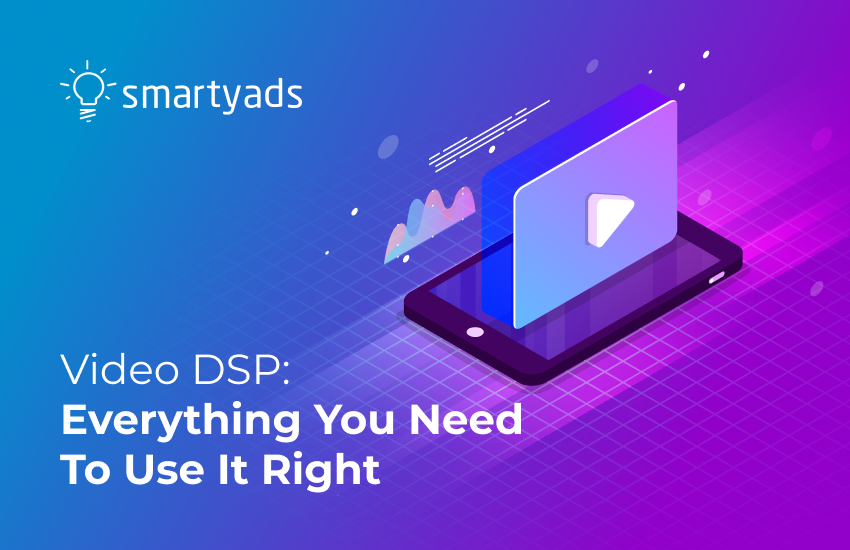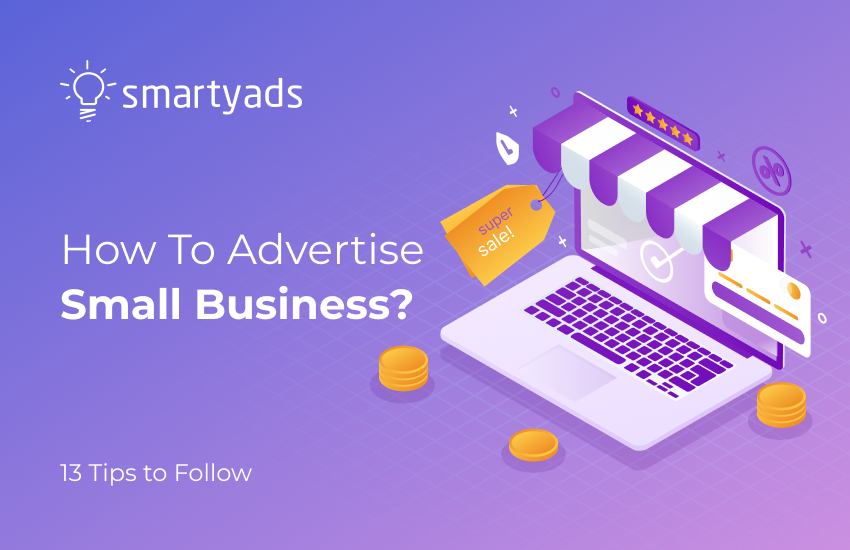The primary purpose of advertising is to catch the customer's attention and convey the ad message. In a world overloaded with impressions, this is challenging.
However, emotional online video ads with spectacular visuals could stand out and catch the user's eye.
The secret of successful video advertising is in psychophysiology. Moving images are much easier to remember than static ones; short video stories are far more interesting than the written word.
A video advertisement can tell more about your product in seconds than many text/images. Indeed, video creative is the most dynamic and colorful format possible.
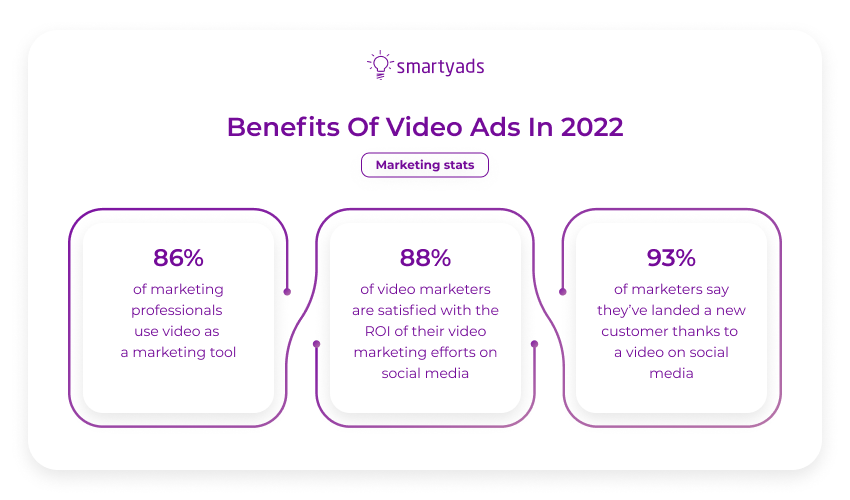
In 2022, video advertising has become even more effective and accessible. Moreover, the influence of video advertising is expected to increase further in the next few years, and its revenue is expected to grow by 70% in 2024 and reach $360 billion by 2027:
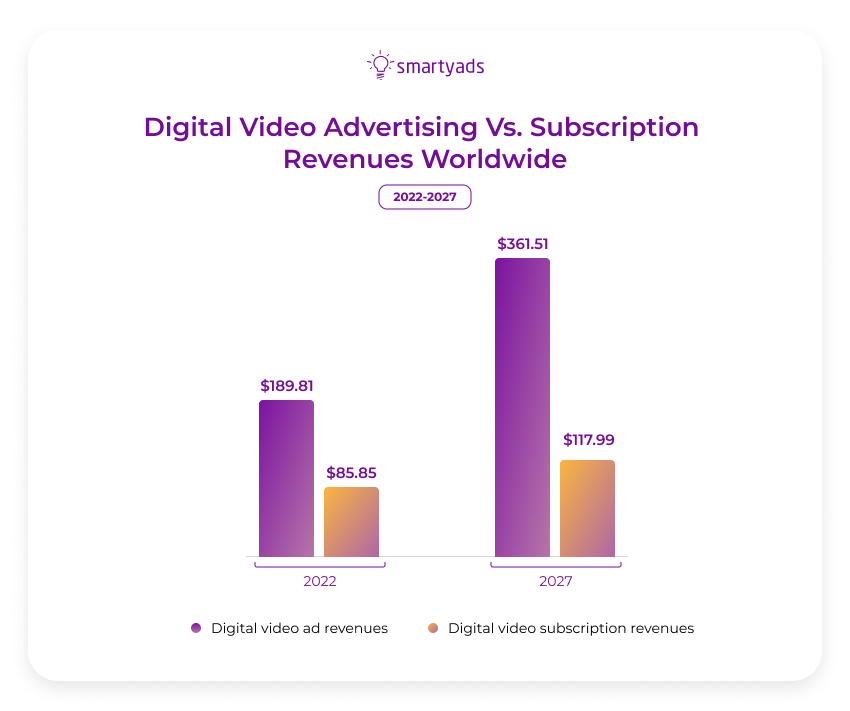
So nowadays, it's pretty challenging to imagine a successful campaign without well-designed video ads.
For better results, we recommend using programmatic video advertising, which helps you successfully place your ads and choose a reliable brand-safe publisher.
Benefits of Video DSP: Brand Safety
Without a doubt, a video has many advantages but costs more than picture advertisements. Moreover, the industry has faced video advertising scams: the websites host ads to maximize their revenues while diminishing the reach of advertising. Unfortunately, for advertisers, it's lost money.
New ways to trick advertisers are coming along day by day. The only way to avoid this — using the right DSP programmatic platforms.
As known, the RTB ecosystem has lots of moving parts. On one side, the Demand-Side Platform allows you to manage video advertising across real-time bidding on ad exchanges. On the other side, publishers use the Supply-Side Platform (inverse of DSP) to sell their ad inventory through an ad exchange during real-time bidding.
With Demand-Side Platforms, advertisers can reach the peak performance of digital video ads in a safe environment.
Plus, there are DSPs of different levels in the advertising ecosystem. But to launch a successful advertising campaign, you need to cover as multiple video ad sizes and formats as possible. Furthermore, creating a clean and safe interaction between the brand and its target audience is vital. Therefore, such opportunities are available only for the best DSPs and Ad Exchanges, such as Amazon DSP Video Ads, SmartyAds DSP, and others.
So, our Demand-Side Platform supports all formats. It's a robust software that uses AI and ML to:
- buy video ads in real time;
- automate all processes;
- optimize the cost-per-click;
- reach the right audience in the right place;
- offer many other benefits for advertisers:
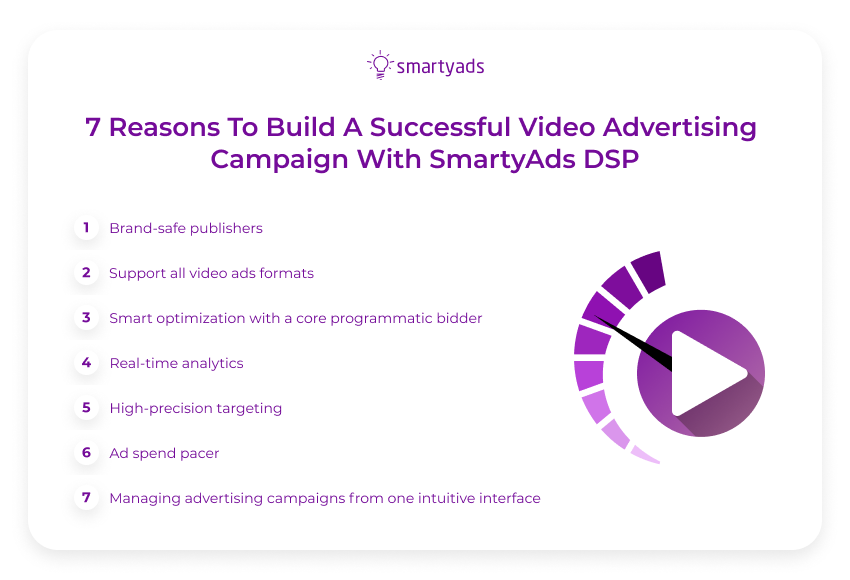
Set up a video ad campaign: step-by-step
We'll break the process into six steps to help you understand how to use the DSP platform and get the best results from the video ads.
Step 1: Creative video digital advertising
Think about how you'd like to make a digital video ad for a potential client. That could be a funny, short, but memorable video. Or a riveting story? Or will you immerse the customer in your busy and successful world so they can trust you?
Consider how you would like to complete a video message in a dynamic format to a potential client.
For example, you can look at the latest trends in digital video advertising:
- Lively and playful animation is an ever-growing trend in online advertising. Pleasant, simple moving graphics are memorable and bring pleasant emotions;
- For connoisseurs of your brand, you can create an explanatory video. This way, you can showcase your services further and show concern for your customers. It is also unobtrusive to demonstrate the value of your B2C or B2B product;
- 360-degree experience is a new format of video announcements. It uses an omnidirectional camera to immerse the user in the right atmosphere.
Such trends are viral in the U.S.
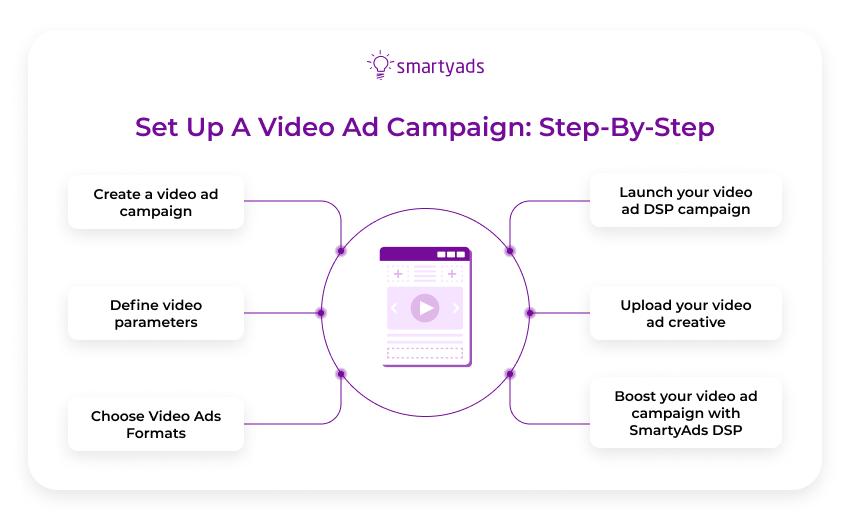
Step 2: Consider the video length and whether it is skippable
Think about the exact place and length of your creative video. In terms of the interactivity of advertising, there are video types: skippable ads and non-skippable ads, playing in video content at the start (pre-roll), middle, and end. Each customization aspect will affect how your potential customers perceive your message:
- Skippable ads do not force users to watch the advertisements till the end;
- Non-skippable ads are the perfect tool if you need a quick conversion. You can force a user to look at an ad; sometimes, that's an excellent tactic. People who watched the video till the end are your potential customers.
Next, timing is everything. The first 5 seconds are the most important. If you fail to interest a potential client initially, a more prolonged viewing will not lead to the desired goal. For this reason, brands focus on the first 5 seconds of a video when creating advertisements. They use humor and try to tell a memorable story that would find the correct emotional response from the user.
Although, longer formats of video ads (over 30 seconds) have also become popular, especially on social media. If the ad is helpful for new customers, why not? Hubspot published research showing that 54% of customers want to see more video ads from their favorite brands.
Step 3: Choose Video Ad Formats
The purpose of video ads is the same as static ads: to reach the right users on the right screen. Videos of different formats can be interactive and non-interactive. Video creative can be full-screen, reflect web content, or be more compact.
To take advantage of video ads, it is essential to learn the most effective mobile/web advertising formats for your strategy.
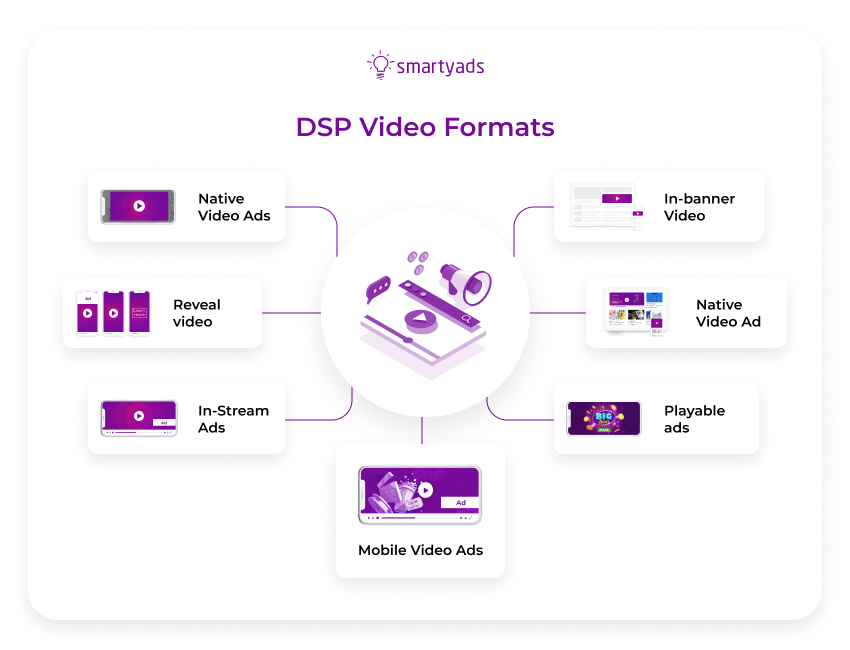
In-Stream Ads: skip
In-Stream is the most popular ad that appears within other digital video content (pre-roll, midroll, or post-roll). Imagine the case: you are eager to see the new podcast on streaming platforms or YouTube, but only you press the play button — the ad comes out. It's awkward, but watching the video will take a few seconds.
Of course, most people realize that this is how they can use free content. So they watch ads with patience. However, someone still installs anti-banners.
Native Video Ads: skillful mimicry
Native (or Outstream) advertising tries to intermix content and website design.
Video Interstitial ad: take a break
Such video advertisements are concise (just a few seconds) and particularly adapted to the mobile web environment. Ads creative appear as little pauses in the game or when the content of the application changes.
In-banner Ads Video: freedom of choice
In-banner video ads are considered less intrusive and help to raise your brand awareness gently. Such banner ads can be easily closed at any time.
Rewarded Video Ads: get a bonus
The user looks at the rewarded ad and interacts with the ad unit itself, carrying out specific actions. In response, they get a bonus, access to premium content, or another reward.
Mobile Video Ads: in time
The mobile ads come at the most appropriate time in various formats, suitable for proper gadgets.
Reveal video: visibility zone
A reveal video is an in-content ad. The advertisement is activated as the user scrolls the page and enters the visibility zone. In this case, the advertising appears between paragraphs of the text in the article (do not confuse it with banner ads) when the user scrolls the page.
Playable ads: game-in-game
Playable video ads are entertaining. While the user is playing a mobile game, they watch a video advertisement for another game for a few seconds.
It doesn't bother the user much.
Step 4: Launch your video ad DSP campaign
We will show you how to create and upload your video ad with SmartyAds Demand Side Platform. It is a single transparent dashboard with easy navigation, which allows you to manage campaigns in one place.
First, choose a campaign type — video:
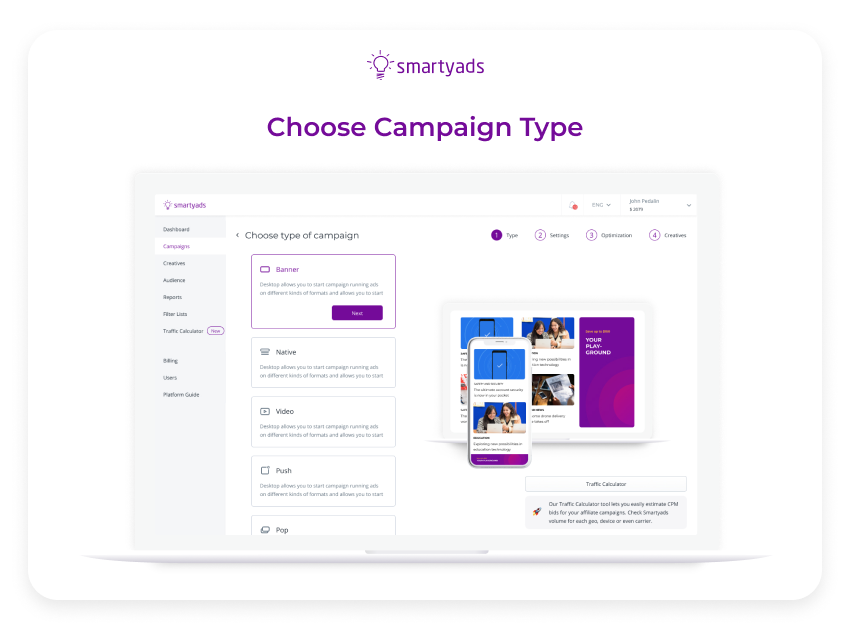
Then fill in the campaign parameters such as targeting options, budget distribution, filters, monitoring, and optimization:
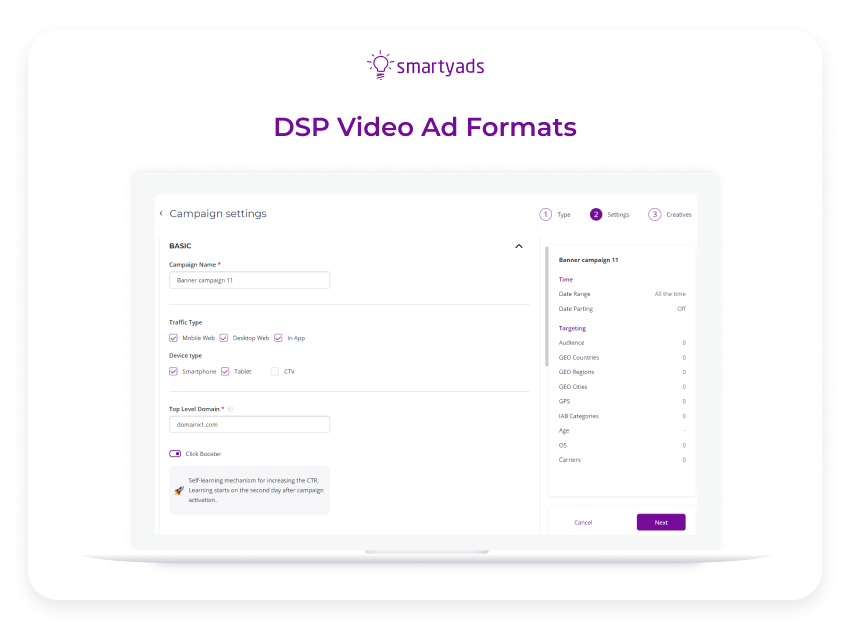
Consider: which audience segments do you need for your video advertising? Who is your ideal customer? For high-quality, sophisticated targeting, you can use demographics, geo, status, age, gender, behavioral habits, and more.
SmartyAds DSP delivers a detailed analysis of what will improve the online advertising strategy. It enables a deeper understanding of all processes, which is valuable for business development.
Besides, you can have a global reach for your audience, bringing the value of your product to each user with each device — the right way to find your ideal customers. You will see the results of the programmatic video advertising launched within the first few days!
Step 5: Upload your video ad creative
Choose these parameters: creative name, the price for 1000 impressions, and frequency.
Name. Give a name to your video creative to set it apart from other creatives. As an example, use your product name and start date.
Click URL. Enter the site URL we will direct the user when they click on the ad.
CPM. Select an acceptable price for a thousand impressions.
Frequency. Choose how many times a day the unique user will be able to view such video advertisements (no more than 2-3 times to avoid irritation).
You can see the valid parameters as minimum video bitrate, required duration, or minimum frame size here:
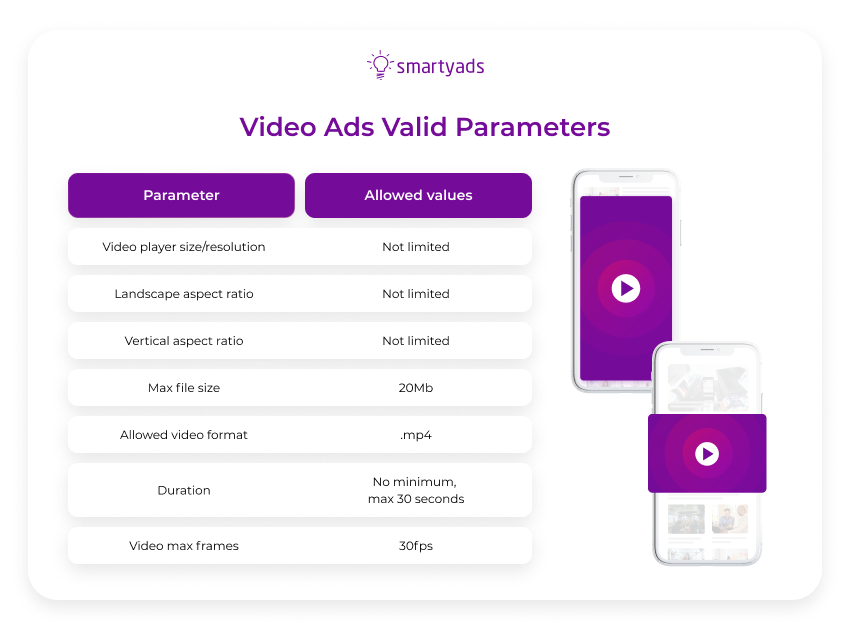
To create video ads, you need a VAST tag in XML format, which is more effective, or a URL.
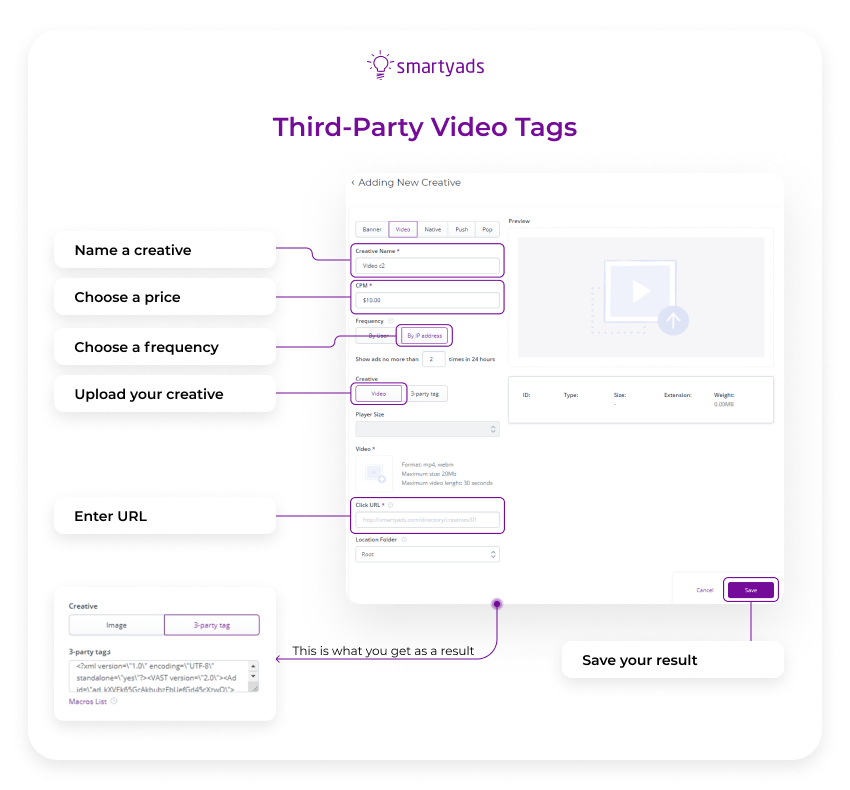
The standard SmartyAds DSP video creative is a file played in front of the video content. It is built into the app or on the site page where video content already exists. Standard video resolutions work better: 300x250, 480x320, 480x360, 640x360, and 720x1280. However, SmartyAds DSP supports non-standard solutions.
You can upload your video file or use third-party video tags. Just:
- describe the video and its parameters in an XML tag;
- insert a link that leads to a video file;
- insert ready XML tag.
The prepared advertisement will be presented as a third-party served tag that any publisher can use on their website or app through intermediary supply-side platforms.
On our DSP, you can add macros to the tag for extra parameters or even use a third-party tag to extract other video advertising.
When you finish downloading creatives, a DSP will automatically find the best place for your video ads at the best price in real-time automatically.
Protect your brand
The real-time interaction of Demand Side Platforms with Ad Exchanges is complicated and, therefore, requires fraud protection of traffic. In particular, we use Protected Media and Pixalate to scan ad inventory to place your ads and The Media Trust to verify the quality of video advertisements. Additionally, DSP helps to find publishers with brand-safe content and the best ad exchanges.
Step 6: Boost your video ad campaign with SmartyAds DSP
Now is the time to experiment with programmatic video advertising, and it is best to do it with the SmartyAds platform.
Our DSP offers fascinating features and add-ons based on its SmartyAds technology. You can target video advertisements, track key performance indicators (KPIs) and keep up with your competitors. Optimize your video ads with the SmartyAds DSP to boost your ad campaign performance on the go!
